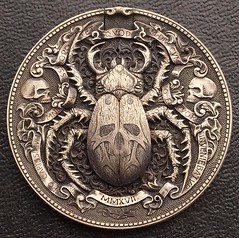
PREV ARTICLE
NEXT ARTICLE
FULL ISSUE
PREV FULL ISSUE
ROMAN BOOTEEN'S MECHANICAL GOLD BUG COIN"Hobo nickel" carvings have some a long way from their itinerant folk art beginnings. Artist carvings on old Buffalo nickels and many other coins have gotten more and
more creative over the years. Here's an amazing creation from a Russian coin carving artist. -Editor
  Russian artist Roman Booteen is a modern master in the art of the hobo nickel—a term used to describe the 18th century sculptural art form of hand-engraving coins. His latest extraordinary piece—titled Gold Bug—was inspired by Edgar Allan Poe's short story, The Gold Bug. It features a central beetle motif with a tailored mechanism that allows its wings to open and close, revealing and concealing its 22K gold body. Carved from two Morgan dollar coins from 1921 and a five dollar gold coin from 2015, the mechanism can be used by pushing a “button” on the coin’s top edge. Framed by elaborate florals, ribbons, and skulls, the Latin script roughly translates to: “The most expensive should be something that was sought longer and intensively than others.” Booteen explains that the coin is a “symbol of treasure hunting,” which is the theme in Poe’s story. The letter “L” on the bug’s body means “50” in Latin, which signifies Booten’s 50th coin carving. Its central beetle motif has a special mechanism that allows its wings to open and close, revealing its 22K gold body. To read the complete article, see:  Wayne Homren, Editor The Numismatic Bibliomania Society is a non-profit organization promoting numismatic literature. See our web site at coinbooks.org. To submit items for publication in The E-Sylum, write to the Editor at this address: whomren@gmail.com To subscribe go to: https://my.binhost.com/lists/listinfo/esylum All Rights Reserved. NBS Home Page Contact the NBS webmaster 
|